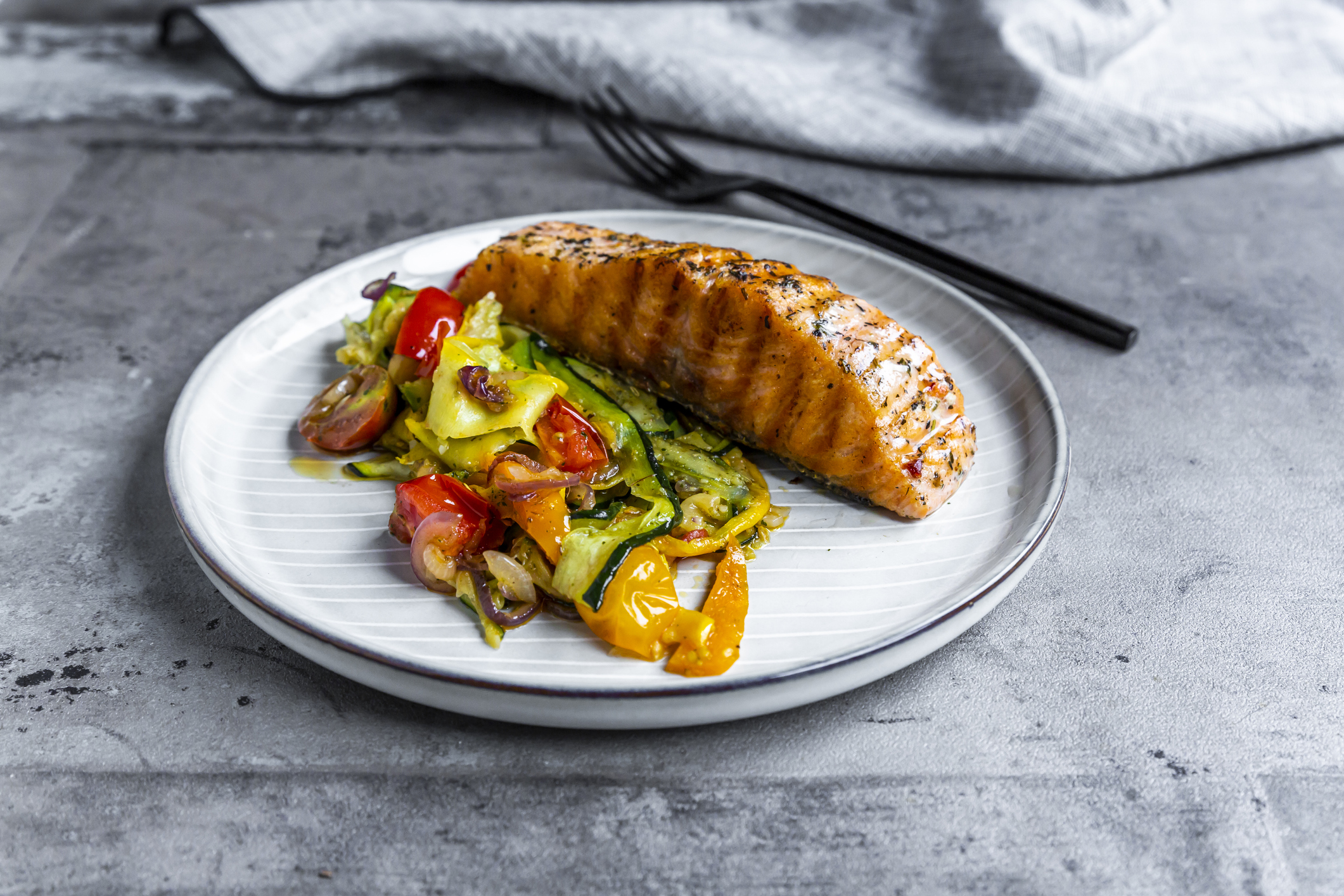The Banting Diet: What to eat on the high fat and low carb plan
Everything you need to know about the Banting Diet, from how to get started to what to eat


The Banting diet was perhaps the first high-fat, low-carbohydrate diet plan to be officially invented.
Brought to life by a man called William Banting in the 19th century, it encourages participants to opt for a low carb diet and instead, fill up on high-fat foods. While this may be simple in theory, it's undoubtedly a restrictive diet as the new plan, revamped by Professor Tim Noakes, encourages people to restrict their calories as well.
No one should be pressured into changing their body but "for those looking to lose weight, it should be done in a healthy way that can be implemented as a lifestyle change, not a 'quick fix'," qualified nutrition coach at OriGym Centre of Excellence, James Brady, says.
What is the Banting diet?
The Banting diet is a high-fat, low-carbohydrate eating plan that was invented in the 1860s by undertaker William Banting. In a booklet called 'Letter on Corpulence, Addressed To The Public', Banting outlined how he managed to successively lose a substantial amount of weight by eating meat, green vegetables, fruits and dry wine while avoiding sugar, starch, beer, milk and butter.
It's the modern version of the Banting diet that's seen a rise in popularity in recent years. Similar to some of the other low-carb, high-fat diets out there, like the keto diet, the Banting diet requires participants to eat particular foods and stick to a lower daily calorie intake.
How does the Banting diet work?
The Banting diet is essentially a low-carbohydrate plan, so it works similarly to others in that it aims to push the body into burning stored fat for energy rather than carbohydrates.
James explains, "The body uses carbohydrates as its main source of energy. To help glucose enter the body's cells, insulin is released so the glucose can be used for energy. This extra glucose is stored in the muscles and liver, while some is converted into body fat. This is how a low-carb diet leads to weight loss, as it is intended to cause the body to burn stored fat for energy."
Parenting advice, hot topics, best buys and family finance tips delivered straight to your inbox.

While some elements of the original Banting diet are used in the new plan, devised by Professor Tim Noakes in The Banting Pocket Guide, the eating plan now comes in four stages.
Four stages of the Banting diet:
Observation
There are no changes to your diet in the first stage of the Banting diet, so you can eat as you normally would.
However, importantly, you must track everything you eat and journal your thoughts after each meal to try and figure out how your body responds to certain foods. I.e. do you feel more full after a high-protein breakfast or a high-carbohydrate meal?
Restoration
In the second stage of the diet, you'll need to eat foods from a series of lists - categorised by various traffic lights.
You're advised to pick foods from Green and Orange lists, which are high in fat and low in carbs, and avoid any on the Red and Light Red lists. These will typically include high carbohydrate food items.
There is no calorie counting or portion control element in this phase of the diet but following a low-carbohydrate recipe may help in sticking to the plan.
Transformation
This is the third stage of the diet and it introduces you an eating plan that's most similar to Banting's original diet.
With your newly-developed eating habits, this stage encourages you to cut your carbohydrate intake to achieve ketosis. It's exactly the same aim as the keto diet and aims to push the body into a zone where it can burn fat quicker called ketosis.
To speed up the process, this third phase encourages participants to stick exclusively to items on the Green list and avoid those on the Orange, Light Red and Red lists. You should also continue to track your meals and track your calorie intake - at least for a couple of weeks.

Tracking your calorie intake is one of the sure-fire ways to ensure that you're maintaining a calorie deficit. Defined as being in a state where you're eating fewer calories than your body needs to function every day, it's scientifically the only way to lose weight - according to a study from the Medical University of Vienna. The Banting diet may be helpful in choosing foods to enter the deficit, following it alone will not enable you to lose weight successively. To find your deficit, use a calorie calculator.
While the first two stages will only last a week each, this phase is longer and participants should continue with it until they reach their desired weight.
To ensure that you don't enter a weight loss plateau, the diet suggests various different tactics - including intermittent fasting and increasing your daily exercise.
Preservation
The fourth stage of the plan is the final one and can carry on for as long as you want - indefinitely even - as it's designed to help you maintain your weight in the longer-term.

As the hard work is done, this is a more flexible stage - but there are still some restrictions. You'll be able to include some of the foods in your diet that you've previously cut out and there's no need to track your food intake.
Instead of such rigid guidelines for eating, foods are divided up into the following categories:
- Green: No limitation, you can have as many of these foods as you like
- Orange: Eat these foods only in moderation where possible
- Light Red: Hardly ever eat these foods, or only on special occasions
- Red: Avoid these foods totally
- Grey: It's up to you whether you eat or don't eat these foods
And if you feel like you've gained weight since entering this phase, the plan says that you can go back to the beginning or back just one step.
This is the grounding for the Banting diet, as described by Professor Tim Noakes. However, you can adapt the plan to suit your own needs. "The level of carbohydrate intake can be adapted to the individual," Prof Noakes says.
"And for those who are concerned about the consumption of too much saturated fat, there is the alternative of using monounsaturated fats like extra virgin olive oil."
What can you eat on the Banting diet?
You can eat foods on the Green list at anytime through the Banting diet. These include:
- Foods high in fat: Avocado, butter and cream
- Vegetables: leafy greens and cruciferous veg, onions, shallots, rhubarb, cabbage, mushrooms and fennel
- Fruits: lemons, lime, tomatoes and olives
- Meat
- Fish
- Poultry
- Dairy, including eggs and cheese
- Fermented foods: Kefir, kimchi and sauerkraut
- Condiments: vinegar, soy sauce and tamari
Along with these foods, the diet allows caffeine-free drinks like herbal tea, flavoured and plain water.
https://www.youtube.com/watch?v=LSjaG67x4aY
You can also eat foods on the Orange list during the first two stages:
- Nuts
- Dairy: milk, yogurt and sour cream
- Fruits: Apples, bananas, oranges and berries
- Vegetables: Beetroot, squash, sweetcorn, carrots and potatoes
- Pulses and legumes
- Fermented foods: kombucha
Caffeinated drinks like tea and coffee are also on the Orange list, so if you're following the plan, you should only have these during the first two phases of the diet.
https://www.youtube.com/watch?v=SSfDrR6bADc
What food should you avoid on the Banting diet?
If you're following the Banting diet, you should avoid foods on the Light Red and Red lists throughout.
Foods on the Light Red list include:
- Smoothies and juices
- High-cocoa chocolate (over 80%)
- Dried fruit
- Honey
- Gluten-free grains: oats, quinoa, rice and buckwheat
- Flours: Gram and rice flours
And foods on the Red list include:
- Fried potatoes, e.g chips
- Foods with added sugar and sweetened condiments, e.g. ketchup
- Confectionary and non-dark chocolate
- Jam
- Golden syrup
- Gluten: Barley, couscous, orzo, rye, semolina, spelt and wheat products
- Grain-based foods: Breakfast cereal and crackers
- Dairy foods: coffee creamers, commercial cheese spreads, ice cream and condensed milk
- Foods high in fat: Processed spreads, corn oil, margarine, sunflower oil
- Processed meats: sausages and any meat cured with sugar
Energy drinks, soft drinks and milkshakes are also included on the Red list as part of the Banting diet.
As evident from the lists above, the Banting diet is highly restrictive. If you want to follow an eating plan that focuses more on including foods in your diet, rather than taking them away, try a more sustainable option like the high protein diet.
How to reduce the side-effects of the Banting diet
When you're on the Banting diet, it's best to increase your water and salt intake to replace what your body has lost.
"Drinking a glass of water mixed with half a teaspoon of salt during your first week of the diet can help ease symptoms. Repeat this once or twice daily," Abbie says.
When you restrict carbohydrates enough to push the body into ketosis, side effects typically include:
- Headaches
- Bad breath
- Weakness and fatigue
- Constipation
- Heart palpitations
These are just some of the reasons that many nutritionists do not recommend the Banting diet - or any low-carbohydrate plan for weight loss.
Is the Banting diet safe?
The long-term effects of the Banting diet are unknown and there's no formal evidence to suggest they are safe if continued, James tells GoodtoKnow.
"While low-carb and the Banting diet can be effect for weight loss in the short-term, the long-term effects of them are unknown and there is no formal evidence to suggest they are safe if continued," he says.
"As Banting is essentially low-cab, high-fat diet, there have been warning about possible health risks regarding strokes, heart disease and diabetes. It's also not recommended for everyone - especially women who are breastfeeding. It can affect the amount of milk produced and may lead to ketoacidosis. This is a life threatening condition where the body runs out of insulin."
If you are looking to lose weight healthily, the NHS advises making an appointment with your GP who will be able to advise on the best strategy for you personally.
The Banting diet - a nutritionist's verdict
It's a no for the Banting diet from our nutritional coach James.
"A scientific study conducted by researchers at Stellenbosch University found there is no difference in weight loss between those who follow low-carb diets and those that follow balanced diets. With this information, it's clear that Banting diets are impractical for long-term weight loss. For those looking to lose weight, it should be done in a healthy way that can be implemented as a lifestyle change, not a 'quick fix'," she says.
"Those looking to lose weight should focus on consuming a balanced diet with plenty of fruit and vegetables and engaging in daily exercise."

Grace Walsh is a health and wellbeing writer, working across the subjects of family, relationships, and LGBT topics, as well as sleep and mental health. A digital journalist with over six years experience as a writer and editor for UK publications, Grace is currently Health Editor for womanandhome.com and has also worked with Cosmopolitan, Red, The i Paper, GoodtoKnow, and more. After graduating from the University of Warwick, she started her career writing about the complexities of sex and relationships, before combining personal hobbies with professional and writing about fitness.